Never Let the World Forget What Happened on D-Day

TODD: Newt Gingrich has a very good idea — and it’s not going to happen, but it’s a very good idea. He wants radio stations to play FDR’s D-Day prayer on June 6. Instead, the mockingbird media will talk about what they pretend to be the insurrection attempt on January 6th — an unarmed attempt.
They will, again, flood the airwaves with that, and clickbait with that, and they will ignore the 1983 actual bombing of a Senate building by an actual domestic terrorist named Susan Rosenberg, who now helps raise money for an actual domestic terror group called Black Lives Matters, Inc. They won’t talk about the bomb that went off with the purpose of killing Republicans in the Senate Building, because that’s certainly not an insurrection.
So that’s where they’ll be focused. Newt says (he’s right) that “Hearing an American President (and the most famous liberal Democrat in history) ask the American people to join in prayer and then openly praying to God is an emotional experience. It would be good for America if each year we remembered D-Day with President Roosevelt’s prayer” for the soldiers at D-Day. It would also be good for Americans, many who have no…They have no blooming clue what Nazism was. Hence, you can have young people who are being trained in the schools of program and elsewhere (but most assuredly in Portland) that they, in fact, are fighting literal Nazis. See, they know the word Nazi is bad. But it’s like hearing about brie cheese. You don’t know how disgusting brie cheese is until you’ve have brie cheese. You’ve heard about it.
And with Nazism, it’s 1,000 times worse. So they don’t even know what that word means. They just know it’s a very, very bad word — and they’re being taught that when they were attempting to kill a literal Nazi. That’s where we’re at. Now, those of us who have not served and have had the opportunity to talk to people who have, particularly, about World War II, and this 77th anniversary of D-Day…
That’s the United States ending Nazism. I recall a friend of mine had learned that… He was adopted. His father was an older father. His father had been involved in the D-Day landings. He was a soldier who stormed the beaches. And my friend came across his pictures and medals. His dad had never… He acknowledged that he served, but never acknowledged his role in D-Day, and so my friend and I had a really bright idea.
“Let’s talk that man into telling us his story.” So one night in his dark apartment upstairs, my friend and I goaded him and cajoled him into telling the story. So he told it. I regret goading him into that, to this day. He said, “We were landing. They were told to get out of the boats; we did. We could hear the explosions coming. We could hear them overhead. We could see the people dying on the beach.
“Somebody yelled, ‘Incoming!’ We went underwater. I didn’t know you could feel the heat from an explosion underwater, but I did. I came up. I grabbed my buddy, grabbed his pack, and said, ‘Run,’ and my friend’s head was gone. God, boys. The water was so damn cold. It was just so cold,” and he stared at the TV.
My friend and I got up and we walked out. We felt terrible for having goaded him into telling us. That’s one of the people who is buried, of course, over there and honored for ending total tyranny and a murderous, socialist regime. In 2013, Rush recalled his trip to Omaha Beach and his feelings in person, the sobering reality of what young men put themselves through to save the world.
RUSH: We went to Omaha Beach, we went to the American Cemetery at Normandy, and we went to Pointe du Hoc. We stopped in three places, touring D-Day locations, and we just barely scratched the surface. The primary location, Omaha Beach, where they do the annual anniversary celebrations, but Omaha Beach is huge.
Then there was Juno Beach further down, and then Utah Beach. And D-Day was a giant, giant act of great deception on the part of Eisenhower. The Germans were entirely faked out — and it’s a good thing, because even being faked out, D-Day was a deadly event.
I couldn’t help while walking the beach at Omaha Beach… We went down to Pointe du Hoc, and gosh, the American Cemetery… I’d seen pictures. You have no idea. It’s like most other things: You have no appreciation for it ’til you’re really there. It’s sobering, folks, and then it’s 69 years ago. And the whole time we’re walking the beach in these locations, I kept having a thought running around in my mind:
“How many Americans even know anymore outside of Saving Private Ryan? How many would even be impressed, if you could take them there and show them the serene place that it is today and say, ‘Guess what happened here 69 years ago. Try to envision 200,000 Americans in oceangoing craft storming this beach, climbing these hills with German gun encampments all over the place mowing ’em down.'”
The Germans even suspected that the invasion might hit Norway and not France. The deception was so good that the German commander Rommel wasn’t even on site on D-Day. He was taking a couple days off. I think it was his anniversary. He was with his wife in Paris or back in Germany or something, and he got the phone call early in the morning, “Guess what, General? We’re under assault here.”
And even with that act of deception, the number of Americans who were killed, Allied forces killed, is stunning. Two hundred thousand, part of the invasion all along the north coast of France, and its importance, that and the Battle of the Bulge, I mean, crucial to stopping what was happening in Europe and preserving Europe and the rest of the world for freedom.
But these Americans along Omaha, all the way down, Juno Beach, Utah Beach, Pointe du Hoc, they were sitting ducks. German installations were high up on the hills. There were bombing runs. In the case of Pointe du Hoc, I think the 9th Army Air Force was launching bombing runs and the number of seagoing efforts to assist in the ground assault which was conducted by the Rangers 2nd Battalion.
Now, this was my first time at Pointe du Hoc. I’d been to this place in my mind but I’d never seen it other than in pictures. It’s a hundred plfeet straight up. The Rangers land on the beach, ships launch ladders and other things on the sides of the cliff to assist the Rangers in climbing up. Germans are shooting down on them, and the Rangers just kept going. Big guns, 155 millimeter guns were up there. They just kept climbing even as the Germans were mowing them down.
Now, one thing, the Germans, because of deception, thought that Utah Beach was gonna be the focus, and they had moved many of the gun installations at Pointe du Hoc a mile west of Pointe du Hoc. They still had some guns but the big guns had been moved on the orders of Rommel. Interestingly, the Ranger rank-and-file landing on the beach and climbing the cliff, they were not told. The Ranger leadership knew that the guns had been moved.
But the Ranger rank-and-file had not been told. It was part of motivation. They had to climb. They had to get that hill. They had to get those installations, whether the Germans were in them or not. They had to shut all that down, all the way up and down the beach. They had to secure that area. And they did. And in a couple of months they’re into Paris and then the Germans are beaten back.
But to see it, folks, so pristine and peaceful now, and to see what these Americans did, climbing straight up those cliffs with ropes, makeshift ladders, with the Germans firing down on them, even though the bulk of the guns had been moved, there was still German small arms fire that was raining down on them, enough to kill them, and a lot were killed. That location I think was one of Ronald Reagan’s greatest ever speeches as president, The Boys of Pointe du Hoc. He gave that speech on the fiftieth anniversary of D-Day.
And then we went to the cemetery, the American cemetery at Normandy. This is one of the most beautiful places I have ever seen and it’s one of the quietest, one of the most sobering places. Every tombstone, every cross is geometrically perfect, no matter what angle, no matter what line you view these crosses, they are in perfect alignment, no matter what angle. And they go on and on, there are 10,000 more. You can’t go there and have any knowledge at all of what happened to not be in awe of what happened, and you can’t go there and not just be thankful.
TODD: We’ll come back and get more to Rush’s observations of D-Day.
BREAK TRANSCRIPT
TODD: Rush took a call from a listener who also visited France and Omaha Beach.
RUSH: Roanoke, Virginia. Hi, Chris. Great to have you with on the EIB Network. Hello.
CALLER: Hi, Rush. I am a long-time listener since 1992.
RUSH: Thank you.
CALLER: And I wanted to comment on your comments about visiting the D-Day beaches. I just came back from France and spent a day at Arromanches, Omaha Beach, and Pointe du Hoc with my two children. My children are age 27, 22. And they both told me that was the highlight of our trip to France. We were in France for eight days. Paris was fine, but the historical value of our visit was tremendous.
Our family was greatly impacted by World War II. My parents, their grandparents, were displaced persons after the war and fled to the U.S. to immigrate. So the effects of World War II are well known by my children as well as the cost of fighting for freedom and the value of freedom. The visit to Arromanches was amazing just to see the artificial port that was put into place by the British. Omaha Beach, to see it with your own eyes, was worth more than a thousand words.
RUSH: Isn’t that incredible? It’s so huge —
CALLER: You can see all the movies you want, but I encourage all your listeners to make a visit just to see the expanse, the distance, the massive length of the beach and then the next beach and the Pointe du Hoc with its lunar craters from bombings still present and you can climb into the bunkers. It was just amazing, and to see the monuments along the beach there and to see the distance with your eyes. It took six hours for these men to get to this point and all the casualties, then go to the cemetery to see the beautiful, beautiful memorial and the endless pool there. It really impacted us.
RUSH: Me, too. It’s impossible for it not to. You say that you hope everybody could go. Most people are never gonna be able to, which is why I’m glad you called. You’re very descriptive. It’s a great way you’ve told the story. What happened in World War II and the bravery of Americans in reclaiming that continent, it’s indescribable. I hope in describing it I can somehow convey the sheer unique bravery and audacity of what was attempted and what was achieved, what was accomplished against the odds.
You walk through that cemetery, I’ll tell you the reaction I had, the American cemetery at Normandy. The wind is always blowing there; it’s never really still. It’s on the coast. It was cold. Even though it was sunny, it was chilly. It always is. You always have to bundle up. But it’s nevertheless strikingly beautiful today. You walk through that cemetery, and you see these tombstones and the Stars of David, and they are aligned perfectly.And no matter which direction you look they are perfectly aligned, no matter what angle, they’re perfectly aligned. You can’t help but be moved by it. And then you look at the names and the dates of the death of everybody on the tombstones, and you see 18 to 22, 18 to 30, and every tombstone represented a life, somebody was alive, somebody was living before that day, and they died for people they would never meet. They died for people they would never know. To me, it’s profound.
TODD: “No greater love has man than to lay his life down for his brother.” It is profound. End of Transcript,

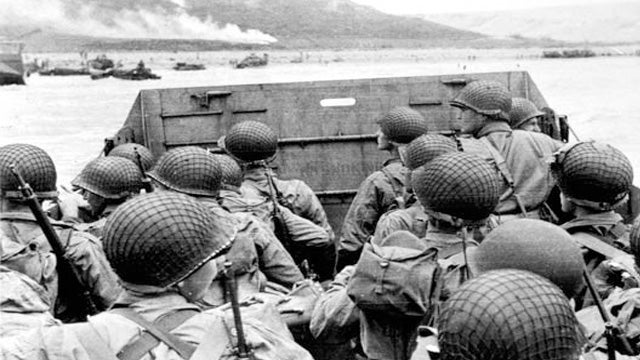
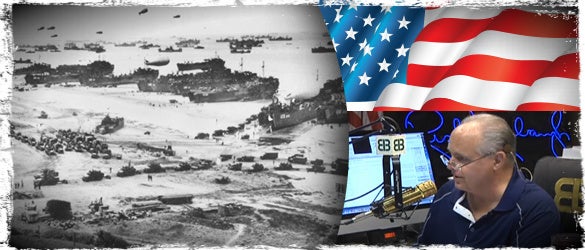
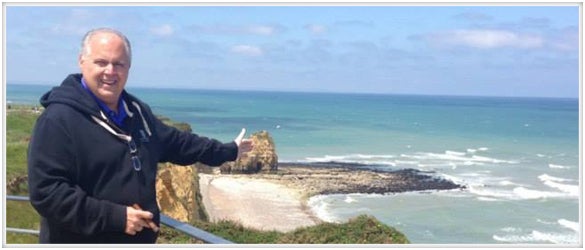
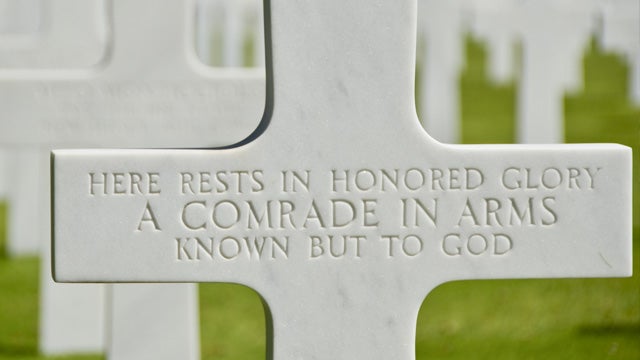
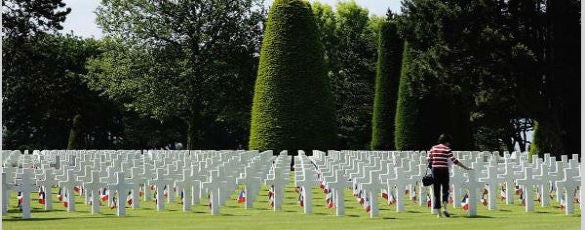

Comments are Closed